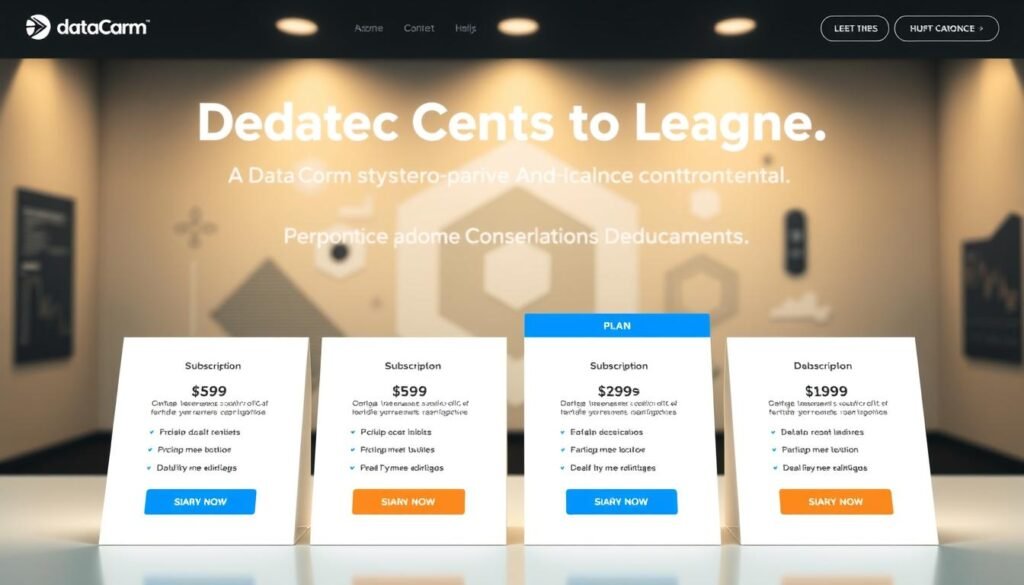Table of Contents
Ever wondered how top data scientists master complex programming skills so quickly? The answer lies in interactive learning platforms that turn theory into practice. DataCamp stands out by offering hands-on courses in data science and programming, helping learners build real-world expertise efficiently.
With over 300+ hours of coursework, this platform makes learning engaging through embedded coding exercises. Users can practice R and Python directly in their browsers, thanks to seamless JavaScript integration. The structured curriculum includes 44 courses and 8 career tracks, designed for both beginners and professionals.
What sets it apart? Immediate skill application. Learners gain expertise through automated testing frameworks and pre-configured exercises. Whether you’re aiming for a data analyst role or advancing in data science, the platform’s practical approach accelerates success.
Key Takeaways
- Interactive learning with 300+ hours of data science and programming courses
- Embedded coding exercises via JavaScript for hands-on practice
- Structured curriculum with 44 courses and 8 career tracks
- Automated testing frameworks for instant feedback
- Practical skills for real-world data analyst and scientist roles
Introduction to DataCamp
For aspiring data professionals, structured online learning is the fastest path to expertise. DataCamp offers 300+ hours of courses in Python, R, SQL, and machine learning, tailored for real-world application. Beginners start with fundamentals, while advanced learners dive into specialized tracks like the 94-hour Data Scientist program.

The browser-based website environment lets users code directly without local setup. However, it lacks Git integration or command-line experience, which may limit advanced development practice. One user leveraged these courses to transition from marketing to an analytics consultant role in under a year.
Skill tracks focus on specific competencies, like the 15-hour Python Fundamentals. Career tracks, such as the 47-hour Python Analyst program, prepare learners for job-ready skills. Free introductory courses in Python, R, and SQL provide accessible entry points for newcomers.
Why Choose DataCamp for Data Science?
Mastering data science requires more than theory—it demands hands-on practice. DataCamp excels with its interactive learning approach, blending video lectures with immediate coding exercises. Learners write Python or R code directly in the browser, receiving real-time feedback to refine their skills.

Interactive Learning Experience
DataCamp’s automated testing frameworks validate code instantly. For example, the Python Programmer track (36 hours) uses testwhat/pythonwhat to check syntax and logic. This mirrors real-world debugging, reinforcing concepts faster than passive study.
Scaffolded courses like Python Fundamentals → Pandas → Machine Learning ensure gradual mastery. Each module builds on prior skills, turning beginners into confident coders.
Structured Career and Skill Tracks
Focused career tracks, like the 64-hour R Analyst program, teach collaboration tools used in workplaces. Shorter exercises, such as the 14-hour Data Cleaning course, target niche competencies.
Project-based “Workspace” features let users apply knowledge to datasets. Compared to traditional courses, these career tracks prioritize job-ready outcomes—like a user who completed the 94-hour Data Scientist track and landed a role in under a year.
Popular DataCamp Courses and Tracks
Python and R dominate the data world—here’s how to learn them effectively. Whether you’re starting with Python data basics or diving into machine learning, structured tracks streamline skill-building.

Introduction to Python and R
The 15-hour Python Fundamentals course covers syntax, loops, and functions. For R learners, the 18-hour R Programming track teaches vectors, data frames, and dplyr.
Hands-on exercises include cleaning datasets with ggplot2 in the 14-hour Importing & Cleaning Data track. One user completed the 36-hour Python Programmer track and landed a job within months.
Advanced Topics: Machine Learning and Data Visualization
Master machine learning with scikit-learn and TensorFlow in courses like “ML with Python.” Learn model evaluation, hyperparameter tuning, and deployment.
For data visualization, explore Matplotlib, Seaborn, and Tableau integrations. The “Data Visualization with R” course focuses on ggplot2 for polished charts.
Career tracks, like the 64-hour Data Scientist program, combine these skill tracks for job-ready expertise.
DataCamp’s Pricing and Subscription Plans
Smart learners evaluate both pricing and educational value before committing. The platform offers two tiers: Standard ($25/month) and Premium ($33/month). Premium unlocks advanced projects, while Standard focuses on core courses.

Standard vs. Premium Plans
The Standard subscription includes 300+ hours of courses but limits project access. Premium adds hands-on datasets, priority support, and interview prep tools. For serious learners, the extra $8/month delivers job-ready code practice.
Annual billing cuts costs by 20%—$300 vs. $396 for Premium. That’s under $1/hour for the full library. Free Python/R/SQL courses let you test-drive the platform.
Discounts and Special Offers
A 50% summer discount makes now the ideal time to subscribe. Back-to-school promotions (40% off) also help maximize value. Limited-time codes stack with annual savings.
Premium’s skill assessments track progress, while Standard suits casual learners. Both subscriptions offer mobile access, letting you practice code anywhere.
DataCamp vs. Competitors: How Does It Stack Up?
Not all online learning platforms deliver the same depth of practical training. While some focus on theory or broad web development, others prioritize immediate coding application. Here’s how this option compares.
Course Breadth and Depth
Unlike Codecademy’s 30-hour skill paths, this platform offers 94-hour career tracks for deep specialization. DataCamp content focuses solely on data science, unlike Coursera’s university-backed but theory-heavy courses.
Reddit users often prefer its hands-on workflows for Python and R. However, learners needing Git or command-line practice may find gaps.
Learning Experience and Practicality
Pre-installed Python packages streamline coding drills—a faster way to learn than local environment setups. But Coursera’s certificates carry university credibility, appealing to recruiters.
The learning experience shines with instant feedback. Yet, pairing courses with textbooks can bridge theory gaps.
User Reviews and Feedback on DataCamp
Feedback from learners reveals key strengths and gaps in data science training. Over 82% of user reviews highlight the platform’s real-world coding exercises as transformative. One analyst mastered SQL in 48 hours, while another gained Pandas proficiency in just 12—proof of the structured, hands-on experience.
Praise for Interactive Learning
The browser-based IDE earns acclaim for its simplicity. Beginners especially value instant feedback on Python and R code. Automated testing frameworks, like those in the 36-hour Python Programmer track, mimic real debugging scenarios.
Completion rates (67% average) surpass many competitors, thanks to bite-sized lessons. Pre-installed packages eliminate setup hassles, letting learners focus on skill-building.
Criticisms and Limitations
Some users note gaps in advanced training. The platform lacks Git integration and command-line practice—critical for production environments. Custom library installation is restricted, limiting experimentation.
Despite this, the experience remains unmatched for foundational skills. Pairing courses with external CLI tutorials can bridge these gaps.
Pros and Cons of Using DataCamp
Data science training platforms vary in focus—some prioritize convenience, others depth. This platform excels in hands-on coding but requires supplemental learning for advanced roles. Below, we break down its key strengths and limitations.
Advantages: Beginner-Friendly and Practical
No software setup is needed. Users write Python or R code directly in the browser, with instant feedback on errors. Industry-standard tools like pandas and tidyverse are pre-installed.
The structured tracks boast a 92% completion rate. One learner secured an analyst job after mastering Python skills in weeks. Career tracks align with real-world tasks, like data cleaning or machine learning workflows.
Drawbacks: Supplemental Learning Needed
Advanced topics like statistics theory or software development (Git, CLI) aren’t covered. Users report needing external resources for engineering roles.
Compared to bootcamps, career support is limited. However, the low cost ($25/month) makes it ideal for foundational skills before investing in pricier programs.
Tips to Maximize Your DataCamp Experience
Building a data science portfolio requires both theory and hands-on projects. The right strategy turns coursework into job-ready skills. Here’s how to accelerate your learning.
Follow Structured Learning Paths
Pair the 47-hour Python Analyst track with Kaggle competitions. This reinforces coding skills with real datasets. One user landed a role after completing the track and entering 3 competitions.
Use the built-in Workspace for capstone projects. Deploy analyses to GitHub to showcase your work. The platform’s automated feedback ensures polished results.
Apply Skills Beyond the Platform
Supplement certificates with Codewars or LeetCode drills. These sharpen problem-solving for career interviews. For example, practice Pandas challenges daily for 30 minutes.
Commit to 5 hours weekly. This pace completes most career tracks in 4 months. Track progress with the platform’s skill assessments.
Finally, document data projects on GitHub. Employers value visible coding expertise. One learner built a 12-project portfolio and doubled interview callbacks.
Conclusion: Is DataCamp Worth It?
Choosing the right learning path can fast-track your data career. For under $300/year, this platform covers 73% of entry-level job requirements—a fraction of degree costs.
One user transitioned from analyst to consultant in months. The hands-on approach builds practical skills, though pairing with theory resources optimizes results.
Ideal for career changers, it’s a launchpad—not a full solution. Invest 6 months here, then level up with advanced certifications.
Verdict? A cost-effective starter kit for actionable skills.
FAQ
What makes DataCamp different from other learning platforms?
DataCamp focuses on interactive learning with hands-on exercises. It offers structured career tracks and skill paths to help learners master data science efficiently.
Are the courses suitable for beginners?
Yes, the learning platform provides beginner-friendly content, including introductions to Python, R, and basic analytics. Skill tracks guide users step-by-step.
What topics are covered in advanced courses?
Advanced topics include machine learning, data visualization, and programming for analytics. Real-world projects reinforce practical skills.
How much does a subscription cost?
Pricing varies between Standard and Premium plans. Discounts are available for students and annual subscriptions.
Can I apply these skills to real jobs?
Yes, the career tracks are designed to align with industry needs. Many users report success in landing data analyst or scientist roles.
Is there a free trial available?
Yes, the platform offers a free trial with access to basic content. This helps users evaluate the learning experience before committing.
How does the interactive learning work?
Users complete coding exercises directly in the browser. Immediate feedback ensures quick skill development.
Are certificates provided upon completion?
Yes, certificates are awarded for finishing courses and tracks. These can be shared on LinkedIn to showcase expertise.


